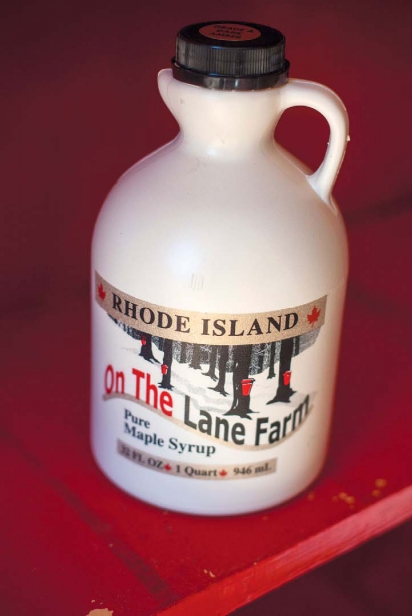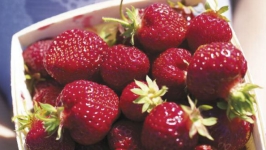Liquid Harvest: On the Lane Farm's Maple Syrup
“Patience is bitter, but its fruit is sweet.”
—Jean-Jacques Rousseau
Like true New Englanders, the black, red and sugar maples so plentiful in our region know how to prepare for winter. They store their energy—glucose in the form of starch—in their roots and trunk. As soon as Mother Nature provides the warm days and cold nights of spring, the starch converts to sugar, which rises in the sap.
It isn’t known when, why or how Native Americans determined to glean the blood of the maples in springtime and distill it until it became amber, saccharine and precious. What is known is tribes ranging from the Atlantic coast all the way to the Great Lakes share similar legends of the sacred creation of maple sap.
The myths are all variations of this: In the beginning, sweet syrup flowed out of the maple trees as easily as a river. But the people became lazy, which offended the gods. So the deities of the forest transformed and diluted the trees to only contain sap.
Of the many legends that exist, the message is clear—nature’s gifts must not be given too freely, lest the people destroy themselves in their sloth.
True to legend, the collection and reduction of maple sap, or “sinzibukwud,” Algonquian for “drawn from trees,” into syrup remains an arduous process. Sap varies from 1% to 2% sugar. It takes 43 gallons of 2% sap to make just one gallon of syrup. You have to work very hard for the gift of sweetness, and that’s where Bill Tabor comes in.
As one of the leading sugarmakers in Rhode Island, Tabor’s job is to catch as much sap in the five to eight weeks of suitably warm days and cold nights as possible. When the trees start to bud in warmer temperatures, the sap turns “nasty” and it’s all over. The sugar season is a short, unpredictable marathon.
THE MECHANICS OF THE MAPLES
A far cry from the bucket-and-boil method of the Native Americans and their colonist students, modern sugaring is a constantly evolving game of technology whose winners score high on volume and efficiency.
In the woodlands along and across the Scituate Reservoir, Tabor has 2,725 taps at his command—all connected in a vast web of tubes about six feet off the ground that transport the sap from tree to tank to truck over hundreds of acres he leases from the Providence Water Board. All the processing is done six miles away in Foster at his home—On the Lane Farm.
I visit him in both locations one clear, frigid morning in early March, two weeks later than anticipated. The winter, one of the harshest in years, left the woods packed with waist-high snow up until last week. Today is the first day the sap is flowing, and Tabor is anxious to be so behind schedule.
“We’re scared right now that this might be a bad year because it’s been so cold so late. The last five years I was tapped and running by mid-January,” he explains.
Tabor, a powerfully built man in his 60s, and John Nugent, “my right- and left-hand man,” get to work right away checking for frozen lines and leaks. They say their greatest enemies are the squirrels, who use the oddly beautiful network of sky blue lines as a superhighway and incessantly chew tiny holes.
When he’s satisfied that everything’s in order, it’s time to flip the switch on the vacuum pump and start pulling. “If things don’t blow up, then we’re in business,” he says with a wry smile.
The system is like a giant Rube Goldberg machine: When enough sap collects in the line, it triggers a release to spill all at once into the 1,500-gallon holding tank. Tabor then transfers 325 gallons of it into the tank in his Ford F-250, and drives it to the farm to begin processing while Nugent continues working in the woods.
“I’ve had days where this thing is running, running all at once. It’s all very specific, things that have been invented over time to make our lives a little easier,” Tabor says of his mechanical woodland orchestra. “This is easier than lugging buckets.”
One of the few surviving sugaring tools from the colonial era is the sap hydrometer, a sleek little device invented in 1768 that measures the sugar density of the sap. Now, Tabor sticks one into the tank to get a reading, hoping to see it close to 2%.
He shouts into the sun-speckled trees, “Hey John! What do you think the sap’s running?”
“I dunno, what?” Nugent replies.
“1.7!” Tabor turns to me and says, “We’re getting good sugar. It’s gonna be a good day.”
ON THE LANE
Back at the farm, the process is just getting started. First up is the reverse osmosis machine, where high turbine membranes force about 10% of the water in the sap away from the sugar, leaving two products: concentrate and permeate. The permeate gets pumped into a holding tank to await its final task of washing all the equipment, while the concentrate moves on to the evaporator.
A hulking beast of a machine, the evaporator is where the real transformation occurs in a series of rectangular pans where the sap is boiled, filtered and finished.
Tabor says despite having purchased all this impressive machinery just six years ago when he began his operation, it’s quickly becoming outdated.
“Maple syrup [industry] is changing as we speak,” he says. “Everybody’s trying to become more efficient. But it’s the same with any passion—the more you invest your soul in it, the more you have to invest your money too.”
So what drew Tabor into this laborious race, modernizing an ancient agricultural tradition?
A native of Maine, Tabor grew up with blueberries, Christmas trees, and “a little bit of maple syrup” on his family’s property. His wife, Susan, comes from a more traditional farming background, and always dreamed of running an apple orchard. After a long career in commercial real estate, they decided to make use of the 70 acres they owned in Foster and Glocester. After concluding that an apple orchard would require harmful chemicals to get started, they looked around and saw they already had a lot of trees—maples.
At the time, Tabor was a member of the nonprofit Rhode Island Forest Conservation Organization, which promotes sustainable forest business opportunities. He wrote a proposal to the Providence Water Supply Board asking for a contract to tap the trees near the reservoir in exchange for a fee per tap. They accepted, and that was it—a sugarmaker was born.
SWEET FINISH
The final step from tree juice to jonnycake cloak is the canning process. Tabor waits until he receives his commercial wholesale orders for this stage in the operation, which involves re-heating the syrup (to 200°) and pouring it into individual bottles (pre-labeled in Turners Falls, Massachusetts).
Just six years into the operation and you can find On the Lane syrup at Dave’s Markets throughout Rhode Island, get it home delivered by Munroe Dairy, or pick some up at the historic Brown & Hopkins Country Store in Chepachet.
Susan says she loves going to the stores and seeing it on the shelves.
“When we drive around in the truck it’s got a big sign on it and people are always tooting and waving! You know what you’re making is a good product and you feel good about that.”
After slathering a fat jonnycake—originally “journey cake” when taught to colonists by the Native Americans—with the thick, grade A stuff on a Sunday morning, it’s impossible to disagree. All that hard work is definitely worth the effort.
Liza Burkin is a freelance writer, adventurer, pedicabber and program manager at Bike Newport. She is a graduate of the University of Wisconsin– Madison’s School of Journalism and Mass Communications.
Look for On the Lane Farm maple syrup at Eastside Marketplace, Dave’s Market (throughout Rhode Island), through Munroe Dairy delivery, or at Brown & Hopkins Country Store in Chepachet.







